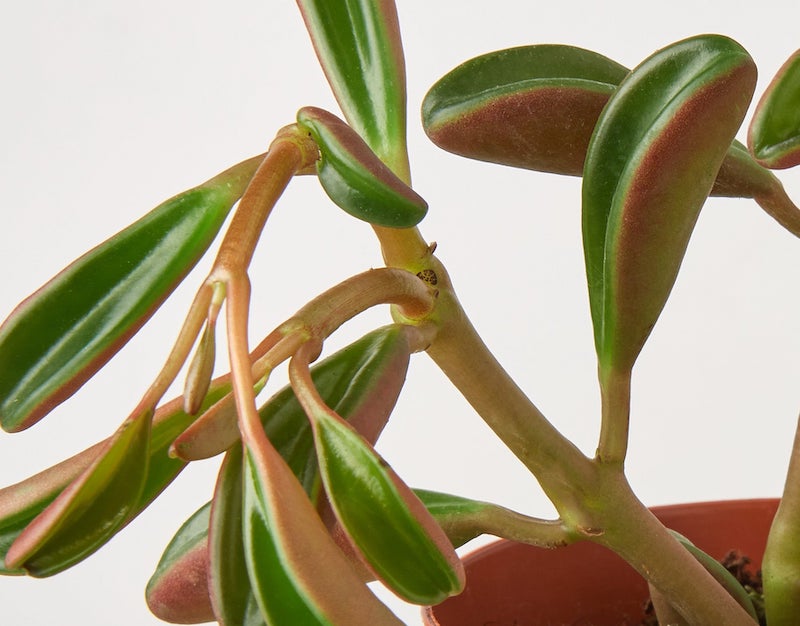Do you love Peperomia’s succulent-like foliage? Wishing you had its twin? It’s easy to propagate this tropical beauty; a beginner can do it. Add a few stem or leaf cuttings to water or soil, and in 4 to 6 weeks, you will have beautiful baby clones of this popular pleaser.

Methods To Propagate Peperomia
There are four ways to propagate Peperomia: air layering, division, seeds, and cuttings. Of these four methods, stem/leaf cuttings have the highest chances of success for beginners propagating most varieties of Peperomia. This process involves choosing a stem with three leaf pairs and cutting it just below the node, about an inch below the lowest pair. Then, after removing the two lower leaf pairs, dip the stem in rooting hormone and plant it in moist seed starter soil consisting of perlite and peat moss. If using a leaf cutting, remove the petiole from the stem, dip it into the rooting hormone, and place it in seed starter soil. Finally, mist the stem and leaf cuttings with water, put them in warm, bright indirect light, and allow 4 to 6 weeks for the roots to grow.

Best Rooting Media To Propagate Peperomia
Several growth mediums support successful propagation of Peperomia by stem/leaf cuttings. These mediums include water and starter seed soil mixtures that you can make with perlite, peat moss, coco coir, and compost, or buy commercially. A superb combination is perlite and peat moss. Perlite supports proper aeration and drainage, and peat moss helps retain adequate moisture.
Steps To Propagate Peperomia
Step 1 - Select a healthy, green stem or leaf to ensure photosynthesis can occur.
Step 2 - Use scissors cleaned with alcohol to cut a stem containing three leaf pairs just below the node about an inch below the lowest pair of leaves. If using a leaf cutting, remove the petiole from the stem.
Step 3 - Dip the stem/leaf cutting into rooting hormone. If using organic gardening practices, use organic rooting hormone. If not, use synthetic auxin, or plant growth hormone, IAA (indoleacetic acid).
Step 4 - Place the stem/leaf cutting into water or a moist seed starter mix.
Step 5 - Mist the stem/leaf cuttings every few days to maintain damp soil. If using water as a rooting medium, replace the stale water every 3 to 5 days with fresh, tepid water.
Step 6 - Cover the container with a clear plastic bag.
Step 7 - Place in warm, bright indirect light. If natural lighting is unavailable, use grow lights instead.
Step 8 - Wait 4 to 6 weeks for roots to grow.
Step 9 - Transplant new plantlets into a container filled with houseplant potting soil, perlite, and peat moss.
Caring For Peperomia Cuttings
Provide continuous moisture to ensure Peperomia cuttings grow roots and don’t die. If using water as a rooting medium, replace the stagnant water with fresh, tepid water every 3 to 5 days, and if using a seed starter soil, mist the substrate every 3 to 4 days. To maintain a warm, humid environment, preferably 90% humidity and above, cover the container with a plastic bag and keep it in temperatures of 70 to 75 degrees. Lastly, the cuttings should receive 12 to 13 hours of indirect light or 16 to 18 hours of artificial light.
Transplanting Peperomia Cuttings
In 4 to 6 weeks, Peperomia’s cuttings should produce roots; when the roots are 1 to 2 inches long, the cuttings are ready to be transplanted. Choose a small 3 or 4-inch pot filled with potting soil mixed with perlite and peat moss. Lightly dampen the soil before transplanting the plantlet to its new substrate. You can transplant it again to a larger pot later, but for now, allow its roots to grow with less moisture-holding substrate rather than more. Fertilize lightly with a balanced (10-10-10) liquid fertilizer diluted to 50% of the label strength. Place Peperomia in warm, indirect light and watch it grow.
 |
Author Suellen Barnes - Published 3-21-2023 |
